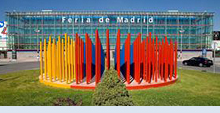 |
European Planetary Science Congress 2012
IFEMA-Feria de Madrid
23 – 28 September 2012, Madrid, Spain |
 |
|
SB2 Observing and modelling meteoroid entry in planetary atmospheres |
| Convener: Apostolos Christou | Co-Conveners: Maria Gritsevich , Jürgen Oberst , Anastasios Margonis |
|
Oral Program
/ Wed, 26 Sep, 14:30–16:00
/ Room Uranus
Poster Program
/ Attendance Thu, 27 Sep, 18:15–19:45
/ Poster Area
|
More than 10^7 kg of extraterrestrial objects or meteoroids ranging in size from a few microns to tens of meters in diameter enters the Earth’s atmosphere every year. A small fraction of these yields free samples of extraterrestrial matter - meteorites - for laboratory study. The majority, which burn up or ablate completely in the Earth’s atmosphere, appear as visible meteors in the night sky. Recording meteor activity and modelling the process of ablation allow us to measure directly the flux of small planetary impactors. This provides the “ground truth’’ for estimating present cratering rates and planetary surface ages by implication. In addition, meteoric metals deposited in the upper atmosphere by incoming meteors affect its properties in ways that are, even today, the topics of intense debate. Last but not least, the application of the latest observational and modeling techniques has rendered meteor science as one of the leading avenues for investigating the nature and origin of interplanetary matter and its parent bodies.
As we extend our presence, either in robotic or human form, on or around other planets and satellites, the discipline will undergo the logical next step, which is the extension of meteor investigations beyond 1 AU using the atmospheres of other planetary bodies as meteoroid detectors. Our ability to glean scientific knowledge from such observations depends critically upon the available models as well as the types of instrumentation used.
Past attempts at direct or indirect, intended or sependipitous detection of meteoroid entry and its effects in the atmospheres of Mars, Venus and Jupiter has highlighted the need for customized instrumentation of the type never before flown as part of a planetary mission. In addition, ablation models used to extract meteoroid parameters from the meteor data are fine-tuned, to a certain degree, for the specific parameters of Earth’s atmosphere. It is necessary, therefore, to construct and qualify a new family of models to deal specifically with meteoroid entry in atmospheres of different composition and structure than the Earth’s.
This session will provide a forum for presenting new results and new ideas in this area and informing the broader planetary science community of the potential interdisciplinary impact of present and future work.

